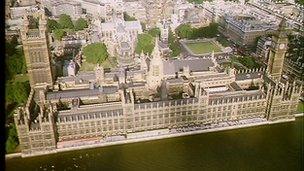Tender process under way for renovation of Houses of Parliament
- Published

The Palace of Westminster is increasingly in a state of disrepair
Parliament has begun a tender process for the renovation of the historic Palace of Westminster.
The building suffers from flooding, has outdated electrical and drainage infrastructure, is full of asbestos and has fire safety issues.
One of the options being considered will involve both the Commons and the Lords sitting in another location while the Palace is refurbished.
The work, unlikely to begin before 2018 at the earliest, may cost about £1.5bn.
A recent report concluded the cost of maintenance is such that if the Palace was a commercial building of no historical significance it would be considered cost-effective to demolish it and rebuild using modern construction techniques.
A contract to examine the feasibility, costs and benefits of three different renovation options, external was put out to tender on 15 May.
The successful bidder will advise the parliamentary authorities whether to carry on repairing the building piecemeal as now, attempt a full renovation while Parliament is still sitting in the Palace, or find another venue for Parliament to sit in while the empty Palace is renovated.
Once the contractor is appointed, it will be expected to report within a year.
"Partial collapse"
A report commissioned by the parliamentary authorities in 2012 highlighted the poor state of repair of Britain's seat of government.
Amongst the issues raised were steam leaks which risked distributing asbestos around the Palace and leaking roofs, water pipes and toilets making flooding a "common occurrence".
The building lacks a fire sprinkler system or the sort of fire doors which keep fire contained in a single area, which are common in other commercial buildings. Parliamentary authorities have received advice that some of the cast-iron roofs are in danger of partial collapse if nothing is done.
The report also said that the basements and air-vents are full of electrical and mechanical infrastructure, which is in an uncertain condition. This is because the Palace has been added to on an ad-hoc basis throughout its existence.
The majority of the historic building was built as a replacement for a previous amalgamation of buildings which burnt down in 1834.
The Commons chamber was destroyed in the blitz in 1941 and after some debate it was decided that it should be rebuilt in exactly the same style after the war.
- Published30 October 2012
- Published23 January 2012